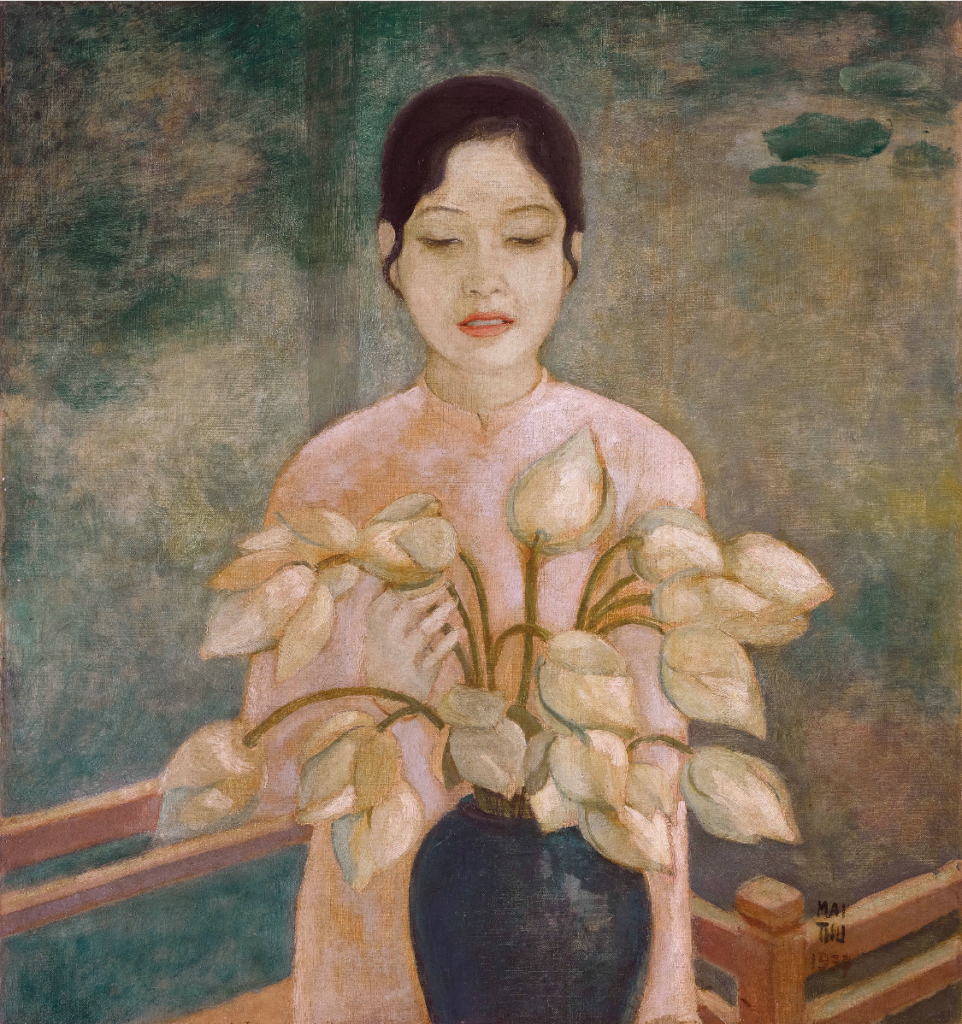The Young Lady of Hue – A masterpiece by Mai Thu
Love is always a betrayal. To think it takes courage, to know it requires experience and to paint it demands talent.
In Hue, 1937, Mai Thu painted this magnificent and in way this one-off piece for different to his usual style at the time with beautiful women and well behaved children in a slightly stiff atmosphere. The gouache and the ink on silk are mediums he will use much later on. But, to describe and to capture for ever his dazzling love, the great master decided a medium he could work with thoroughly, oil on canvas, a technique that allows repentances at the difference of paint on silk laid on paper.

The story about this painting is well known : in 1937, at a time Mai Thu was graduated from the Fine-Art School of Hanoi since already 7 years, and since then worked for the Lycée of Hue as a drawing teacher. It is then, that what couldn’t happen was not meant to happen, happened : he fell mad in love with one of his students, and the student is the girl we can see, here, on this portrait. The grand master he, contrary to his more later and more conventional portraits, breaks away by offering us a recognizable face. Not only a face but also a posture. The beautiful young girl, her eyes looking down, dressed with in a traditional ao dai girl, her face framed by two short strands of hair otherwise up in a bun it seems. She doesn’t pose, she is captured by the artist. Every detail is gracious, elegant and delicate in just, among all, the way she touches with her hand the explosion of delicious flowers. Cleverly, the artist surrounds her with quite a neutral background mostly defined by a few lines describing a fence so the viewer is drawn by the intense relationship, in that instant, between the young lady and the flowers.
It is like Mai Thu, in his creation, was inspired by Man Giac (1052-1096), a mandarin’s son (so was Mai Thu) in these following verses :
Spring goes, a hundred flowers fall
Man Giac
Spring comes, a hundred flowers smile
Before the eyes, life passes by
On my head, age has settled
Don’t think when spring ends, all the flowers fall
Last night in the courtyard, an apricot blossomed.
The freshly cut lotus flower, not yet open, represent the freshness of his love for the young girl. A kind reminder of the fragility part of a flying moment, it’s grace, that cannot last. A meaningful painting he even took with him on the boat, in 1937, when he left for Paris to attend the Universal Exhibition. She then stayed in Hue.
The splendors of Paris, the close company of friends with Le Pho (settled definitively in Paris the same year), Vu Cao Dam (who arrived in 1931) then Le Thi Luu (1940), in the hard times of the war against Germany, the first successes, but… nothing will make him forget his loved one, the young lady of Hue. He saw his close friends, Vu Cao Dam and Le Pho, get married with French women but even then, Mai Thu remained faithful to his love… feeling strongly a cultural nostalgia for Vietnam, as was also a very talented player of Dan Dôc Huyen, a one-string musical instrument.
In 1962, Mai Thu makes the big decision, he chose to return to his Vietnam 25 years later. He then found out that his loved one was no longer in Hue but in Saigon. He did see her again. But, according to the owner of the painting who witness their meeting together, the charm was broken : the young lady was the mother of a large family and the magic has disappeared… and Mai Thu came returned to France.
It is said that the painting was exhibited in Paris in 1937 before the wife of Mai Thu’s brother bought it from him in 1959 as a present to celebrate her son’s and his wife first diplomatic posting as he became the Chancellor for France in Ceylan.
Mai Thu, the most Vietnamese of the ‘Parisian’ group, a lover of Vietnamese traditional music, also a filmmaker, was never able to forget her coolish smile mixed with the immanent grace of the young girls of Hue. Furthermore, he probably never forgot the fresh and pure air, cold or hot, coming from the mountains of Laos, traveling along the waters of the magnificent River of Perfumes.
Nguyen Binh (1918-1966) relates so well the drift of his thoughts in the « The Boat Girl » :
After three years had passed spring came again
Nguyen Binh – The Boat Girl
But time had brought her passion to an end
No need to wait for what seasons may bring
She gave up her dream of seeing that friend.
Farewell boat, farewell rowing, farewell tide
The batgirl left as another man’s bride,
But since her leaving the river that spring
Many longed for the face of their young guide.
Jean-François HUBERT